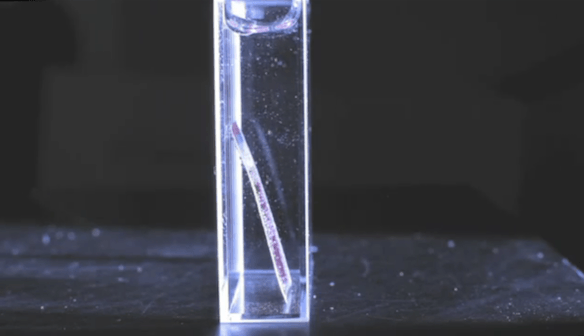Artificial Leaf Mimics Photosynthesis To Produce Energy
October 04, 2011
on
on

An artificial leaf developed at MIT mimics the first stage of photosynthesis. It utilizes sunlight to cause a chemical reaction which produces hydrogen.
The leaf consists of a thin sheet of silicon which is placed in a bucket of water. When sunlight hits the sheet it starts a process of electrolysis decomposing the water in oxygen en hydrogen. The gases can be captured and used to power a fuel cell.
Daniel Nocera Professor of Chemistry at the Massachusetts Institute of Technology is the lead researcher on the project. He sees a future in which people can use the technology to generate their own electricity on their rooftops. The leaf is made from cheap materials that are copiously available on earth in order to make the device affordable. All you need to generate your own hydrogen is a bucket of water.
At this point in time storing the highly explosive hydrogen still poses difficulties. But in combination with other technologies being developed right now –such as storing hydrogen in the fluid carbazole to nullify hydrogen’s volatile nature- the artificial leaf brings a clean powered future one step closer.
In 2008 Nocera and his team discovered that a material called cobalt phosphate works as a catalyst to release oxygen molecules (O2) from water when an electrical current is applied.
The silicon sheet acts as a photovoltaic cell: when sunlight strikes the cell part of the energy is absorbed causing an electric current. By attaching a layer of cobalt phosphate to one side of the silicon sheet, the researchers had developed a sun-powered device that oxidizes water.
But they hadn’t found a way to form hydrogen molecules (H2) yet. The hydrogen ions (H+) were loosed from their bonds to the water molecules (H20) but they weren’t forming hydrogen molecules. The team solved this by applying a layer of nickel-molybdenum-zinc alloy to the other side of the silicon sheet. This catalyst material causes the hydrogen ions to combine with electrons forming hydrogen molecules.
Currently the device converts 2.5% of the sun’s energy it captures into hydrogen. Nocera will continue his research to make the leaf both more energy efficient en less expensive.
The findings were published in the September issue of Science.
Source: MIT.edu
Photo: source MIT.edu
The leaf consists of a thin sheet of silicon which is placed in a bucket of water. When sunlight hits the sheet it starts a process of electrolysis decomposing the water in oxygen en hydrogen. The gases can be captured and used to power a fuel cell.
Daniel Nocera Professor of Chemistry at the Massachusetts Institute of Technology is the lead researcher on the project. He sees a future in which people can use the technology to generate their own electricity on their rooftops. The leaf is made from cheap materials that are copiously available on earth in order to make the device affordable. All you need to generate your own hydrogen is a bucket of water.
At this point in time storing the highly explosive hydrogen still poses difficulties. But in combination with other technologies being developed right now –such as storing hydrogen in the fluid carbazole to nullify hydrogen’s volatile nature- the artificial leaf brings a clean powered future one step closer.
In 2008 Nocera and his team discovered that a material called cobalt phosphate works as a catalyst to release oxygen molecules (O2) from water when an electrical current is applied.
The silicon sheet acts as a photovoltaic cell: when sunlight strikes the cell part of the energy is absorbed causing an electric current. By attaching a layer of cobalt phosphate to one side of the silicon sheet, the researchers had developed a sun-powered device that oxidizes water.
But they hadn’t found a way to form hydrogen molecules (H2) yet. The hydrogen ions (H+) were loosed from their bonds to the water molecules (H20) but they weren’t forming hydrogen molecules. The team solved this by applying a layer of nickel-molybdenum-zinc alloy to the other side of the silicon sheet. This catalyst material causes the hydrogen ions to combine with electrons forming hydrogen molecules.
Currently the device converts 2.5% of the sun’s energy it captures into hydrogen. Nocera will continue his research to make the leaf both more energy efficient en less expensive.
The findings were published in the September issue of Science.
Source: MIT.edu
Photo: source MIT.edu
Read full article
Hide full article


Discussion (0 comments)